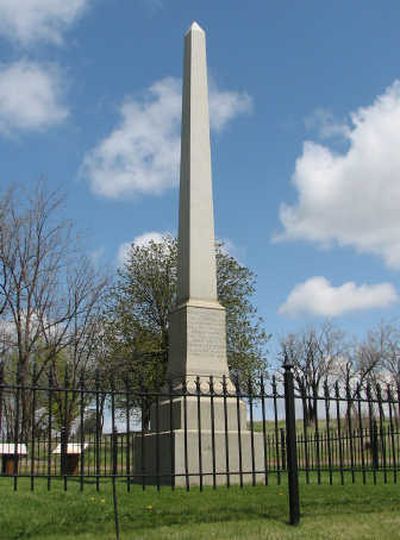Historians, tribes keep story of Steptoe alive

ROSALIA, Wash. – The situation was desperate for Lt. Col. Edward Steptoe and his men, down to their last few rounds of ammunition after a day of fighting Indian warriors from numerous tribes.
But darkness came, and Steptoe’s force managed to escape, ending a battle 150 years ago that eventually led to the brutal subjugation of tribes in the Inland Northwest.
While Steptoe was maligned in life for losing the battle on May 17, 1858, it was only because of his military skills that his corps was not wiped out as Custer’s 7th Cavalry was 18 years later.
David Nicandri, of the Washington State Historical Society, said the relatively little-known Battle of Steptoe was a turning point in the white takeover of the Inland Northwest.
“It was the classic iconic configuration of the Army fighting the Indians,” Nicandri said. “The Indians won more of these perhaps than might be commonly thought.”
Indians refer to it as the Battle of Tohotonimme.
Frank SiJohn, a Coeur d’Alene tribal member whose ancestor Victor died in the battle, has worked to keep the story of the battle alive with members of the tribe. From the Indian perspective, Steptoe provoked the encounter by deliberately crossing into tribal lands, SiJohn said.
“They scolded him and told him he was not supposed to be there,” SiJohn said.
There was relatively little fighting between Indians and whites in the Pacific Northwest. The Yakama Wars of 1855-‘58, of which the Battle of Steptoe Butte was a part, were the exception.
Steptoe, 43 at the time, was a West Point graduate, decorated and promoted for bravery in the Mexican War 12 years earlier.
He was initially sympathetic to the Indians, believing whites should be kept out of the “great rectangle,” as the area north of the Snake River and east of the Columbia River was known.
Steptoe and 160 members of his 9th Infantry rode from Fort Walla Walla on May 6 in response to tribal unrest at a white settlement and to investigate the alleged killings of white prospectors headed to the Colville area.
Because they did not expect battle, the soldiers carried light weapons and only about 40 rounds of ammunition each.
They reached the area that is now the town of Rosalia on May 16, where they were confronted by what Steptoe estimated to be 800 to 1,000 warriors of the Spokane, Palouse, Coeur d’Alene, Yakama and other tribes. The warriors spent the day harassing his column “by yells, taunts, and menaces” Steptoe later wrote.
At dusk the soldiers made camp and some chiefs approached to ask Steptoe’s purpose. Steptoe said he was on his way to Colville and wanted to restore peace.
The chiefs pointed out the soldiers were well off the normal trail to Fort Colville and refused Steptoe’s request for canoes necessary to cross the Spokane River. That made proceeding pointless, and Steptoe decided to return to Walla Walla.
After a sleepless night during which his force was kept awake by Indian drumming, dancing and shouting, Steptoe started marching back toward the Snake River.
But the well-armed Indians attacked, launching a day-long battle across the rolling hills of the Palouse.
Though outnumbered and outgunned, Steptoe was able to reach higher ground. He selected a spot for a last stand and the soldiers dug in, beating back several charges led by the Yakama chief Kamiakin.
The Indians broke off their attacks as darkness fell, not knowing the soldiers were down to about three rounds each.
Steptoe’s surviving officers persuaded him to try to escape during the night. The soldiers dumped most of their equipment, stole through a gap in the Indian lines and galloped south.
The Indians charged the hill at dawn, only to find it deserted.
There’s a school of thought that the Indians, fearing Army retaliation and guided by their Catholic faith, allowed Steptoe and his men to escape.
“Outright killing like that is not a good solution,” SiJohn said.
Steptoe’s men reached Fort Walla Walla on May 22, having suffered seven deaths. As many as nine Indians were dead, with 40 to 50 wounded.
But one soldier – Sgt. Edward Ball – was also missing. He had been left in charge of keeping campfires lit while the main force escaped.
One of his jobs was to make sure the surgeon’s supply of medicinal whiskey did not fall into Indian hands. Ball did such a good job that he passed out and woke up in a clump of bushes May 18 to find himself all alone. He walked to Fort Walla Walla, later became a Union Army major, and survived the Battle of the Little Bighorn.
Steptoe’s defeat prompted his superior officer, Col. George Wright, to lead 600 well-armed troops against the Indian tribes.
On Sept. 1, Wright defeated a large force of Spokane, Palouse and Coeur d’Alene Indians at the Four Lakes area. On Sept. 5, Wright beat the Indians again in the Battle of Spokane Plains.
Wright marched toward Cataldo Mission in Idaho, destroying Indian homes, food and livestock. The soldiers captured more than 800 horses near present-day Liberty Lake, and spent two days slaughtering most of them to demoralize the Indians and break their ability to wage war.
Indians consider Wright’s campaign “a search and destroy” mission on the tribes, SiJohn said.
The soldiers destroyed the Indians’ winter provisions and killed the horses used in hunting, he said.
“Wright came up and destroyed everything,” SiJohn said, endangering the lives of the women, children and elders of the tribes. “That is not an honorable way of fighting war.”
A peace meeting was held Sept. 22 at Latah Creek near Spokane. Wright ordered Yakama Chief Qualchan, and several other Indians, hanged on the spot for their roles in the fighting.